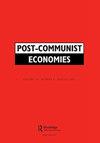Two sides of the same coin? Viet Nam’s macro resilience under trade-led growth
IF 1.8
3区 经济学
Q2 ECONOMICS
引用次数: 0
Abstract
ABSTRACT Viet Nam is following the successive waves of rapid industrialisation in Asia by implementing an export-oriented growth strategy. The country is strongly integrated into global value chains. However, a key concern is whether such trade-led growth is sustainable in the long run and resilient to global shocks. Drawing on a multi-country balance-of-payments-constrained growth model, our objective in the present paper is threefold. Firstly, we examine Viet Nam’s growth performance over the past 30 years of transition and integration. More specifically, we measure the respective contribution of partner areas to its external constraint. Secondly, we analyse how and through which transmission channels the changing geography of international trade has impacted the balance-of-payments-constrained growth rate before and after Viet Nam joined the WTO in 2007. A decomposition of the external constraint into different factors from different sources is proposed in order to assess the outcomes of WTO accession. Lastly, we assess the country’s ability to face the current Covid-19 pandemic. Given its deep integration into the global economy, the geography of trade relations is critical in determining Viet Nam’s vulnerability. This corroborates recent development studies that make a case for partner diversification and growth re-orientation in order to build macro resilience.同一枚硬币的两面?越南在贸易带动增长下的宏观韧性
摘要:越南正在追随亚洲快速工业化的浪潮,实施出口导向型增长战略。该国已融入全球价值链。然而,一个关键的问题是,从长远来看,这种贸易主导的增长是否可持续,是否能抵御全球冲击。基于多国国际收支约束增长模型,本文的目标有三个。首先,我们审查了越南在过去30年的过渡和一体化中的增长表现。更具体地说,我们衡量伙伴领域对其外部约束的各自贡献。其次,我们分析了在越南2007年加入世贸组织前后,国际贸易地理格局的变化如何以及通过哪些传导渠道影响了国际收支受限的增长率。提出将外部约束分解为来自不同来源的不同因素,以评估加入WTO的结果。最后,我们评估该国应对当前新冠肺炎大流行的能力。鉴于越南与全球经济的深度融合,贸易关系的地理位置对于决定越南的脆弱性至关重要。这证实了最近的发展研究,这些研究为合作伙伴多样化和重新定位增长以建立宏观韧性提供了理由。
本文章由计算机程序翻译,如有差异,请以英文原文为准。
求助全文
约1分钟内获得全文
求助全文
来源期刊

Post-Communist Economies
ECONOMICS-
CiteScore
4.90
自引率
18.20%
发文量
21
期刊介绍:
Post-Communist Economies publishes key research and policy articles in the analysis of post-communist economies. The basic transformation in the past two decades through stabilisation, liberalisation and privatisation has been completed in virtually all of the former communist countries, but despite the dramatic changes that have taken place, the post-communist economies still form a clearly identifiable group, distinguished by the impact of the years of communist rule. Post-communist economies still present distinctive problems that make them a particular focus of research.
 求助内容:
求助内容: 应助结果提醒方式:
应助结果提醒方式:


